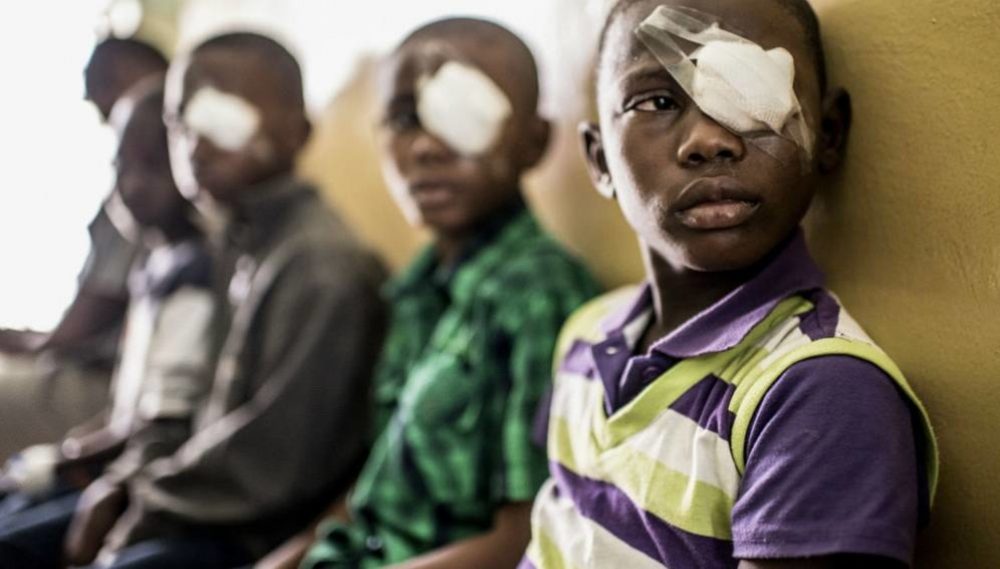Trachoma Fact Sheet

Trachoma is the leading infectious cause of blindness worldwide. It is caused by an obligate intracellular bacterium called Chlamydia trachomatis.
Fact Sheet
Key facts
- Trachoma is a disease of the eye caused by infection with the bacterium Chlamydia trachomatis.
- It is known to be a public health problem in 41 countries, and is responsible for the blindness or visual impairment of about 1.9 million people. In 2016, 190.2 million people lived in trachoma endemic areas and were at risk of trachoma blindness.
- Blindness from trachoma is irreversible.
- Infection spreads through personal contact (via hands, clothes or bedding) and by flies that have been in contact with discharge from the eyes or nose of an infected person. With repeated episodes of infection over many years, the eyelashes may be drawn in so that they rub on the surface of the eye, with pain and discomfort and permanent damage to the cornea.
- In 2016, more than 260 000 people received surgical treatment for advanced trachoma, and 85 million people were treated with antibiotics. Global-level antibiotic coverage was 44.8%, a considerable increase compared to the 29.6% coverage achieved in 2015.
Trachoma is the leading infectious cause of blindness worldwide. It is caused by an obligate intracellular bacterium called Chlamydia trachomatis. The infection is transmitted through contact with eye and nose discharge of infected people, particularly young children who harbour the principal reservoir of infection. It is also spread by flies which have been in contact with the eyes and noses of infected people.
Clinical characteristics and morbidity
In areas where trachoma is endemic, active (inflammatory) trachoma is common among preschool-aged children, with prevalence rates which can be as high as 60–90%. Infection becomes less frequent and shorter in duration with increasing age. Infection is usually acquired when living in close proximity to others with active disease, and the family is the main setting for transmission. An individual’s immune system can clear a single episode of infection, but in endemic communities, re-acquisition of the organism occurs frequently.
After years of repeated infection, the inside of the eyelid can become so severely scarred (trachomatous conjunctival scarring) that it turns inwards and causes the eyelashes to rub against the eyeball (trachomatous trichiasis), resulting in constant pain and light intolerance; this and other alterations of the eye can lead to scarring of the cornea. Left untreated, this condition leads to the formation of irreversible opacities, with resulting visual impairment or blindness. The age at which this occurs depends on several factors including local transmission intensity. In very highly endemic communities, it can occur in childhood, though onset of visual impairment between the ages of 30 and 40 years is more typical.
Visual impairment or blindness results in a worsening of the life experience of affected individuals and their families, who are normally already amongst the poorest of the poor. Women are blinded up to 4 times as often as men, probably due to their close contact with infected children and their resulting greater frequency of infection episodes.
Environmental risk factors influencing the transmission of the disease include:
- poor hygiene
- crowded households
- water shortage
- inadequate latrines and sanitation facilities.
Distribution
Trachoma is hyperendemic in many of the poorest and most rural areas of 41 countries of Africa, Central and South America, Asia, Australia and the Middle East.
It is responsible for the blindness or visual impairment of about 1.9 million people. It causes about 1.4% of all blindness worldwide.
Overall, Africa remains the most affected continent, and the one with the most intensive control efforts. In 2016, in the 26 countries of WHO’s Africa Region in which trachoma is known to be a public health problem, more than 247 000 people with trichiasis were given operations (95% of the global total operated on for trichiasis), and nearly 83 million people in Africa were treated with antibiotics (97% of the total given antibiotics for trachoma worldwide).
Economic impact
The burden of trachoma on affected individuals and communities is enormous. The economic cost in terms of lost productivity from blindness and visual impairment is estimated at US$ 2.9–5.3 billion annually, increasing to US$ 8 billion when trichiasis is included.
Prevention and control
Elimination programmes in endemic countries are being implemented. This consists of:
- Surgery to treat the blinding stage of the disease (trachomatous trichiasis);
- Antibiotics to clear infection, particularly mass drug administration of the antibiotic azithromycin, which is donated by the manufacturer to elimination programmes, through the International Trachoma Initiative;
- Facial cleanliness; and
- Environmental improvement, particularly improving access to water and sanitation.
Most endemic countries have agreed to accelerate the implementation of this strategy to achieve their respective elimination targets, all by the year 2020.
Elimination efforts need to continue to satisfy the target set by World Health Assembly resolution WHA 51.11, which is elimination of trachoma as a public health problem. Particularly important will be the full engagement of sectors involved in water, sanitation and socioeconomic development.
AHO Action Plan
The plan consists of:
- Surgery to treat the blinding stage of the disease (trachomatous trichiasis);
- Antibiotics to clear infection, particularly mass drug administration of the antibiotic azithromycin, which is donated by the manufacturer to elimination programmes, through the International Trachoma Initiative;
- Facial cleanliness; and
- Environmental improvement, particularly improving access to water and sanitation.
Budget for AHO Action Plan
US$55 million
Please donate to help eliminate Trachoma as a public health threat
Sources: WHO, UNDP, PAHO, UN, AU

